Barcelona–Vallès Line
The Barcelona–Vallès Line (Catalan: Línia Barcelona-Vallès) is an unconnected standard gauge rapid transit and commuter railway line linking Barcelona with Sabadell and Terrassa via the Collserola mountain range, in Catalonia, Spain. Its name refers to the Catalan historical region of Vallès, whereby most part of the line runs. Plaça de Catalunya station serves as the Barcelona terminus of the line, where almost all its trains either start or terminate. The line then continues northwards and branches off twice before leaving the city limits. Its main route splits in two in Sant Cugat del Vallès, forming two major branches to Sabadell and Terrassa. It has 40 passenger stations in operation and a total line length of 48.1 kilometres (29.9 mi).
| Barcelona–Vallès Line | |||||||||||||||||||||||||||||||||||||||||||||||||||||||||||||||||||||||||||||||||||||||||||||||||||||||||||||||||||||||||||||||||||||||||||||||||||||||||||||||||||||||||||||||||||||||||||||||||||||||||||||||||||||||||||||||||||||||||||||||||||||||||||||||||||||||||||||||||||||||||||||||||||||||||||||||||||||||||||||||||||||||||||||||||||||||||||||||||||||||||||||||||||||||||||||||||||||||||||||||||||||||||||||||||
|---|---|---|---|---|---|---|---|---|---|---|---|---|---|---|---|---|---|---|---|---|---|---|---|---|---|---|---|---|---|---|---|---|---|---|---|---|---|---|---|---|---|---|---|---|---|---|---|---|---|---|---|---|---|---|---|---|---|---|---|---|---|---|---|---|---|---|---|---|---|---|---|---|---|---|---|---|---|---|---|---|---|---|---|---|---|---|---|---|---|---|---|---|---|---|---|---|---|---|---|---|---|---|---|---|---|---|---|---|---|---|---|---|---|---|---|---|---|---|---|---|---|---|---|---|---|---|---|---|---|---|---|---|---|---|---|---|---|---|---|---|---|---|---|---|---|---|---|---|---|---|---|---|---|---|---|---|---|---|---|---|---|---|---|---|---|---|---|---|---|---|---|---|---|---|---|---|---|---|---|---|---|---|---|---|---|---|---|---|---|---|---|---|---|---|---|---|---|---|---|---|---|---|---|---|---|---|---|---|---|---|---|---|---|---|---|---|---|---|---|---|---|---|---|---|---|---|---|---|---|---|---|---|---|---|---|---|---|---|---|---|---|---|---|---|---|---|---|---|---|---|---|---|---|---|---|---|---|---|---|---|---|---|---|---|---|---|---|---|---|---|---|---|---|---|---|---|---|---|---|---|---|---|---|---|---|---|---|---|---|---|---|---|---|---|---|---|---|---|---|---|---|---|---|---|---|---|---|---|---|---|---|---|---|---|---|---|---|---|---|---|---|---|---|---|---|---|---|---|---|---|---|---|---|---|---|---|---|---|---|---|---|---|---|---|---|---|---|---|---|---|---|---|---|---|---|---|---|---|---|---|---|---|---|---|---|---|---|---|---|---|---|---|---|---|---|---|---|---|---|---|---|---|---|---|---|---|---|---|---|---|---|---|---|---|---|---|---|---|---|---|---|---|---|---|---|---|---|---|---|---|---|---|---|---|---|---|---|
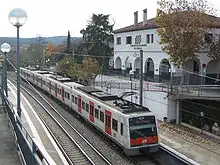 A 112 Series train at Sant Quirze station. | |||||||||||||||||||||||||||||||||||||||||||||||||||||||||||||||||||||||||||||||||||||||||||||||||||||||||||||||||||||||||||||||||||||||||||||||||||||||||||||||||||||||||||||||||||||||||||||||||||||||||||||||||||||||||||||||||||||||||||||||||||||||||||||||||||||||||||||||||||||||||||||||||||||||||||||||||||||||||||||||||||||||||||||||||||||||||||||||||||||||||||||||||||||||||||||||||||||||||||||||||||||||||||||||||
| Overview | |||||||||||||||||||||||||||||||||||||||||||||||||||||||||||||||||||||||||||||||||||||||||||||||||||||||||||||||||||||||||||||||||||||||||||||||||||||||||||||||||||||||||||||||||||||||||||||||||||||||||||||||||||||||||||||||||||||||||||||||||||||||||||||||||||||||||||||||||||||||||||||||||||||||||||||||||||||||||||||||||||||||||||||||||||||||||||||||||||||||||||||||||||||||||||||||||||||||||||||||||||||||||||||||||
| Native name | Línia Barcelona-Vallès | ||||||||||||||||||||||||||||||||||||||||||||||||||||||||||||||||||||||||||||||||||||||||||||||||||||||||||||||||||||||||||||||||||||||||||||||||||||||||||||||||||||||||||||||||||||||||||||||||||||||||||||||||||||||||||||||||||||||||||||||||||||||||||||||||||||||||||||||||||||||||||||||||||||||||||||||||||||||||||||||||||||||||||||||||||||||||||||||||||||||||||||||||||||||||||||||||||||||||||||||||||||||||||||||||
| Status | Operational | ||||||||||||||||||||||||||||||||||||||||||||||||||||||||||||||||||||||||||||||||||||||||||||||||||||||||||||||||||||||||||||||||||||||||||||||||||||||||||||||||||||||||||||||||||||||||||||||||||||||||||||||||||||||||||||||||||||||||||||||||||||||||||||||||||||||||||||||||||||||||||||||||||||||||||||||||||||||||||||||||||||||||||||||||||||||||||||||||||||||||||||||||||||||||||||||||||||||||||||||||||||||||||||||||
| Owner | Government of Catalonia | ||||||||||||||||||||||||||||||||||||||||||||||||||||||||||||||||||||||||||||||||||||||||||||||||||||||||||||||||||||||||||||||||||||||||||||||||||||||||||||||||||||||||||||||||||||||||||||||||||||||||||||||||||||||||||||||||||||||||||||||||||||||||||||||||||||||||||||||||||||||||||||||||||||||||||||||||||||||||||||||||||||||||||||||||||||||||||||||||||||||||||||||||||||||||||||||||||||||||||||||||||||||||||||||||
| Line number | L6, L7, L12, S1, S2, S5, S6, S7 | ||||||||||||||||||||||||||||||||||||||||||||||||||||||||||||||||||||||||||||||||||||||||||||||||||||||||||||||||||||||||||||||||||||||||||||||||||||||||||||||||||||||||||||||||||||||||||||||||||||||||||||||||||||||||||||||||||||||||||||||||||||||||||||||||||||||||||||||||||||||||||||||||||||||||||||||||||||||||||||||||||||||||||||||||||||||||||||||||||||||||||||||||||||||||||||||||||||||||||||||||||||||||||||||||
| Locale | Barcelona metropolitan area | ||||||||||||||||||||||||||||||||||||||||||||||||||||||||||||||||||||||||||||||||||||||||||||||||||||||||||||||||||||||||||||||||||||||||||||||||||||||||||||||||||||||||||||||||||||||||||||||||||||||||||||||||||||||||||||||||||||||||||||||||||||||||||||||||||||||||||||||||||||||||||||||||||||||||||||||||||||||||||||||||||||||||||||||||||||||||||||||||||||||||||||||||||||||||||||||||||||||||||||||||||||||||||||||||
| Termini |
| ||||||||||||||||||||||||||||||||||||||||||||||||||||||||||||||||||||||||||||||||||||||||||||||||||||||||||||||||||||||||||||||||||||||||||||||||||||||||||||||||||||||||||||||||||||||||||||||||||||||||||||||||||||||||||||||||||||||||||||||||||||||||||||||||||||||||||||||||||||||||||||||||||||||||||||||||||||||||||||||||||||||||||||||||||||||||||||||||||||||||||||||||||||||||||||||||||||||||||||||||||||||||||||||||
| Stations | 40 | ||||||||||||||||||||||||||||||||||||||||||||||||||||||||||||||||||||||||||||||||||||||||||||||||||||||||||||||||||||||||||||||||||||||||||||||||||||||||||||||||||||||||||||||||||||||||||||||||||||||||||||||||||||||||||||||||||||||||||||||||||||||||||||||||||||||||||||||||||||||||||||||||||||||||||||||||||||||||||||||||||||||||||||||||||||||||||||||||||||||||||||||||||||||||||||||||||||||||||||||||||||||||||||||||
| Service | |||||||||||||||||||||||||||||||||||||||||||||||||||||||||||||||||||||||||||||||||||||||||||||||||||||||||||||||||||||||||||||||||||||||||||||||||||||||||||||||||||||||||||||||||||||||||||||||||||||||||||||||||||||||||||||||||||||||||||||||||||||||||||||||||||||||||||||||||||||||||||||||||||||||||||||||||||||||||||||||||||||||||||||||||||||||||||||||||||||||||||||||||||||||||||||||||||||||||||||||||||||||||||||||||
| Type | Rapid transit, commuter rail | ||||||||||||||||||||||||||||||||||||||||||||||||||||||||||||||||||||||||||||||||||||||||||||||||||||||||||||||||||||||||||||||||||||||||||||||||||||||||||||||||||||||||||||||||||||||||||||||||||||||||||||||||||||||||||||||||||||||||||||||||||||||||||||||||||||||||||||||||||||||||||||||||||||||||||||||||||||||||||||||||||||||||||||||||||||||||||||||||||||||||||||||||||||||||||||||||||||||||||||||||||||||||||||||||
| Operator(s) | Ferrocarrils de la Generalitat de Catalunya (FGC) | ||||||||||||||||||||||||||||||||||||||||||||||||||||||||||||||||||||||||||||||||||||||||||||||||||||||||||||||||||||||||||||||||||||||||||||||||||||||||||||||||||||||||||||||||||||||||||||||||||||||||||||||||||||||||||||||||||||||||||||||||||||||||||||||||||||||||||||||||||||||||||||||||||||||||||||||||||||||||||||||||||||||||||||||||||||||||||||||||||||||||||||||||||||||||||||||||||||||||||||||||||||||||||||||||
| Depot(s) |
| ||||||||||||||||||||||||||||||||||||||||||||||||||||||||||||||||||||||||||||||||||||||||||||||||||||||||||||||||||||||||||||||||||||||||||||||||||||||||||||||||||||||||||||||||||||||||||||||||||||||||||||||||||||||||||||||||||||||||||||||||||||||||||||||||||||||||||||||||||||||||||||||||||||||||||||||||||||||||||||||||||||||||||||||||||||||||||||||||||||||||||||||||||||||||||||||||||||||||||||||||||||||||||||||||
| Rolling stock |
| ||||||||||||||||||||||||||||||||||||||||||||||||||||||||||||||||||||||||||||||||||||||||||||||||||||||||||||||||||||||||||||||||||||||||||||||||||||||||||||||||||||||||||||||||||||||||||||||||||||||||||||||||||||||||||||||||||||||||||||||||||||||||||||||||||||||||||||||||||||||||||||||||||||||||||||||||||||||||||||||||||||||||||||||||||||||||||||||||||||||||||||||||||||||||||||||||||||||||||||||||||||||||||||||||
| Ridership | 64,101,981 passenger journeys (2018)[1] | ||||||||||||||||||||||||||||||||||||||||||||||||||||||||||||||||||||||||||||||||||||||||||||||||||||||||||||||||||||||||||||||||||||||||||||||||||||||||||||||||||||||||||||||||||||||||||||||||||||||||||||||||||||||||||||||||||||||||||||||||||||||||||||||||||||||||||||||||||||||||||||||||||||||||||||||||||||||||||||||||||||||||||||||||||||||||||||||||||||||||||||||||||||||||||||||||||||||||||||||||||||||||||||||||
| History | |||||||||||||||||||||||||||||||||||||||||||||||||||||||||||||||||||||||||||||||||||||||||||||||||||||||||||||||||||||||||||||||||||||||||||||||||||||||||||||||||||||||||||||||||||||||||||||||||||||||||||||||||||||||||||||||||||||||||||||||||||||||||||||||||||||||||||||||||||||||||||||||||||||||||||||||||||||||||||||||||||||||||||||||||||||||||||||||||||||||||||||||||||||||||||||||||||||||||||||||||||||||||||||||||
| Opened | 24 June 1863 | ||||||||||||||||||||||||||||||||||||||||||||||||||||||||||||||||||||||||||||||||||||||||||||||||||||||||||||||||||||||||||||||||||||||||||||||||||||||||||||||||||||||||||||||||||||||||||||||||||||||||||||||||||||||||||||||||||||||||||||||||||||||||||||||||||||||||||||||||||||||||||||||||||||||||||||||||||||||||||||||||||||||||||||||||||||||||||||||||||||||||||||||||||||||||||||||||||||||||||||||||||||||||||||||||
| Technical | |||||||||||||||||||||||||||||||||||||||||||||||||||||||||||||||||||||||||||||||||||||||||||||||||||||||||||||||||||||||||||||||||||||||||||||||||||||||||||||||||||||||||||||||||||||||||||||||||||||||||||||||||||||||||||||||||||||||||||||||||||||||||||||||||||||||||||||||||||||||||||||||||||||||||||||||||||||||||||||||||||||||||||||||||||||||||||||||||||||||||||||||||||||||||||||||||||||||||||||||||||||||||||||||||
| Line length | 48.1 km (29.9 mi) | ||||||||||||||||||||||||||||||||||||||||||||||||||||||||||||||||||||||||||||||||||||||||||||||||||||||||||||||||||||||||||||||||||||||||||||||||||||||||||||||||||||||||||||||||||||||||||||||||||||||||||||||||||||||||||||||||||||||||||||||||||||||||||||||||||||||||||||||||||||||||||||||||||||||||||||||||||||||||||||||||||||||||||||||||||||||||||||||||||||||||||||||||||||||||||||||||||||||||||||||||||||||||||||||||
| Number of tracks | 2 | ||||||||||||||||||||||||||||||||||||||||||||||||||||||||||||||||||||||||||||||||||||||||||||||||||||||||||||||||||||||||||||||||||||||||||||||||||||||||||||||||||||||||||||||||||||||||||||||||||||||||||||||||||||||||||||||||||||||||||||||||||||||||||||||||||||||||||||||||||||||||||||||||||||||||||||||||||||||||||||||||||||||||||||||||||||||||||||||||||||||||||||||||||||||||||||||||||||||||||||||||||||||||||||||||
| Character | At-grade, underground (in central Barcelona, Sabadell and Terrassa) | ||||||||||||||||||||||||||||||||||||||||||||||||||||||||||||||||||||||||||||||||||||||||||||||||||||||||||||||||||||||||||||||||||||||||||||||||||||||||||||||||||||||||||||||||||||||||||||||||||||||||||||||||||||||||||||||||||||||||||||||||||||||||||||||||||||||||||||||||||||||||||||||||||||||||||||||||||||||||||||||||||||||||||||||||||||||||||||||||||||||||||||||||||||||||||||||||||||||||||||||||||||||||||||||||
| Track gauge | 1,435 mm (4 ft 8+1⁄2 in) standard gauge | ||||||||||||||||||||||||||||||||||||||||||||||||||||||||||||||||||||||||||||||||||||||||||||||||||||||||||||||||||||||||||||||||||||||||||||||||||||||||||||||||||||||||||||||||||||||||||||||||||||||||||||||||||||||||||||||||||||||||||||||||||||||||||||||||||||||||||||||||||||||||||||||||||||||||||||||||||||||||||||||||||||||||||||||||||||||||||||||||||||||||||||||||||||||||||||||||||||||||||||||||||||||||||||||||
| Old gauge | 1,672 mm (5 ft 5+13⁄16 in) | ||||||||||||||||||||||||||||||||||||||||||||||||||||||||||||||||||||||||||||||||||||||||||||||||||||||||||||||||||||||||||||||||||||||||||||||||||||||||||||||||||||||||||||||||||||||||||||||||||||||||||||||||||||||||||||||||||||||||||||||||||||||||||||||||||||||||||||||||||||||||||||||||||||||||||||||||||||||||||||||||||||||||||||||||||||||||||||||||||||||||||||||||||||||||||||||||||||||||||||||||||||||||||||||||
| Electrification | 1,500 V DC overhead lines | ||||||||||||||||||||||||||||||||||||||||||||||||||||||||||||||||||||||||||||||||||||||||||||||||||||||||||||||||||||||||||||||||||||||||||||||||||||||||||||||||||||||||||||||||||||||||||||||||||||||||||||||||||||||||||||||||||||||||||||||||||||||||||||||||||||||||||||||||||||||||||||||||||||||||||||||||||||||||||||||||||||||||||||||||||||||||||||||||||||||||||||||||||||||||||||||||||||||||||||||||||||||||||||||||
| |||||||||||||||||||||||||||||||||||||||||||||||||||||||||||||||||||||||||||||||||||||||||||||||||||||||||||||||||||||||||||||||||||||||||||||||||||||||||||||||||||||||||||||||||||||||||||||||||||||||||||||||||||||||||||||||||||||||||||||||||||||||||||||||||||||||||||||||||||||||||||||||||||||||||||||||||||||||||||||||||||||||||||||||||||||||||||||||||||||||||||||||||||||||||||||||||||||||||||||||||||||||||||||||||
The origins of the line date from 1863, when a privately owned railway from Barcelona to the then-separated town of Sarrià was opened. In 1912, Catalan engineer Carles Emili Montañès created the company Ferrocarriles de Cataluña (FCC) in order to take control of the line and extend it northwards. After successive extensions, the line reached Terrassa and Sabadell in 1919 and 1922, respectively. In 1977, FCC announced that the whole line was to be closed due to the company's bad economic results. Nevertheless, the Spanish government prevented that from happening by taking control of it. The line was transferred to the Catalan government in 1979, and has been operated by Ferrocarrils de la Generalitat de Catalunya (FGC) ever since. Currently, the most prominent intervention on the line is the extension of the Terrassa and Sabadell branches through the construction of a route underneath the two cities; the former was completed in 2015, whilst the latter did so in 2017.[2][3]
Barcelona Metro rapid transit lines 6, 7 and 12 serve the line's urban branches within Barcelona, while the rest of the line is operated as a high-frequency commuter rail system known as Vallès Metro (Catalan: Metro del Vallès). This system further includes the Vallvidrera Funicular, which is also operated by FGC. The Barcelona–Vallès Line is part of the Autoritat del Transport Metropolità (ATM) fare-integrated public transport system for the Barcelona metropolitan area.
History
The Barcelona–Vallès Line was opened in 1863 with the old Iberian gauge of 1672 mm, and was electrified and regauged to standard gauge (1435 mm) in 1905.
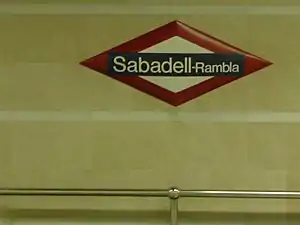
Sabadell Metro (Catalan and Spanish: Metro de Sabadell), is the name of the underground subway line in Sabadell. It is operated by the Catalan government-owned rail company Ferrocarrils de la Generalitat de Catalunya. Construction of the subway line started in late 2006 and was due to be finished by 2011 or 2012, depending on which project the FGC finally decided on.[4] However, work was temporarily halted due to the 2008–2014 Spanish financial crisis,[5] but later resumed and the first phase opened in two stages in September 2016 and July 2017.
The proposed line will join the city centre of Sabadell with its northern neighbourhoods, where it will join the Renfe network line, and will effectively link the city with Barcelona through the main FGC lines. The terminus of the current general FGC line, a station called Sabadell – Rambla, will disappear as it will be replaced by this network. The original project, if fulfilled, will be 4.2 km long.[6] It has been criticised for devising a subway line that would run nearly parallel to the Renfe line, which has been deemed not effective enough to suit the needs of a city the size of Sabadell. Also, a civic association called Sabadell Cruïlla has proposed the construction of a larger metro system to link Sabadell with other large cities in the immediate region such as Terrassa and Granollers.[7] In addition to that, it has proposed several changes to the initial project so the subway line would reach Torreromeu and Polinyà.[8]
Terrassa Metro is the name of the current subway in Terrassa, Catalonia, Spain, operated by the Catalan government-owned rail company Ferrocarrils de la Generalitat de Catalunya (FGC). It could be more accurately defined as an underground addition to the already existing FGC commuter train network in the city, located in the metropolitan area of Barcelona. Construction of the subway line was due to start in 2008 and the date of completion was estimated to be in 2010. The proposed line will link the already existing FGC station Terrassa – Rambla with the Renfe rail line in the city, and will cover a larger portion of the city area, including the Polytechnic University of Catalonia schools located in Terrassa. Construction of the tunnel in Can Roca started in April 2007.[9] Generalitat de Catalunya stated a budget of 178.8 million euros will be available for the construction of the Terrassa Metro,[10] which will be made up of an addition to the Terrassa train stations belonging to the FGC line S1. FGC and Renfe budgets combined sum will sum 321 million euros.[9] Renfe itself is going to build another station in the city: Terrassa Est – Passeig del Camp[11] Parts of the Vallès line operated by FGC are actually known under the collective name of Metro del Vallès since 1996, which will include the Terrassa service and the extension of S2 which will become Sabadell Metro in the almost adjacent municipality of Sabadell, which is already under construction.[12]
Route description
The Barcelona–Vallès Line has its start point at Plaça de Catalunya station, which is located directly underneath El Triangle shopping mall, on the southwesternmost side of Plaça de Catalunya ("Catalonia Square"), a major public transport hub in the Barcelona district of Eixample. The line then continues northwestwards in an underground route along Balmes Street until its intersection with Diagonal Avenue, from this point on running underneath Via Augusta. After Gràcia station, the line branches off thanks to a flying junction,[13] forming a 1.9-kilometre-long (1.2 mi) stretch to Avinguda Tibidabo station.[14] Contrarily to the line's main route, this branch line keeps on running northwestwards, following again Balmes Street up to its northern end, which is also the northern terminus of the branch line.[15]
The main line towards Vallès bends westwards exactly following Via Augusta on its way along the Sarrià-Sant Gervasi district. It branches off again at Sarrià station, forming a 0.6-kilometre-long (0.37 mi) stretch to Reina Elisenda station.[14] The main route, however, continues northwards in a backwards C-shaped route through Barcelona's last streets at the foot of the Collserola mountain range. At this point, the line runs on a succession of alternated open-cut and underground sections before eventually crossing the Vallvidrera neighborhood through a 1.6-kilometre-long (0.99 mi) tunnel in a northwest direction.[16] It then continues going across Collserola's central area above ground, running parallel to C-16 motorway up to Valldoreix station in Sant Cugat del Vallès, passing through Les Planes and La Floresta neighborhoods. Next, the line curves northeasterly, getting closer to Sant Cugat del Vallès city center. It diverges into two main branch lines immediately after Sant Cugat station: the Terrassa branch curves markedly in a west direction, while the Sabadell branch runs northwards.[15]
On the one hand, the stretch to Terrassa continues moving away from Sant Cugat del Vallès in a northwesterly direction towards Rubí, where the line's main depot and operations centre is located. It goes along the western limits of Rubí city centre, describing a straight route northwards to the Les Fonts neighbourhood. The branch line proceeds by slightly curving northwesterly, and penetrates into Terrassa city center through a route underneath Rambla del Pare Alegre and Rambla d'Égara streets.[15] After Terrassa Rambla station, it runs in a S-shaped route, reaching Vallparadís Park, then continuing northwards, terminating at Terrassa Nacions Unides station.[17]
On the other hand, the stretch to Sabadell curves northeasterly as it approaches the end of its route through Sant Cugat del Vallès. It then passes through Cerdanyola del Vallès's Bellaterra neighborhood before curving notably in a southwest direction and, shortly after, again in a northeast direction, reaching the Bellaterra campus of the Autonomous University of Barcelona.[15] Before curving northwesterly, the branch line crosses a part of the campus thanks to a short tunnel and, about 700 metres (2,300 ft) further,[18] it goes through another short tunnel as it bends west. It curves in a north direction towards Sant Quirze del Vallès immediately after. The line then enters Sabadell in a northeast direction, continuing above ground up to Can Feu | Gràcia station; hereafter, running in an underground route terminating at Sabadell Parc del Nord station.[15]
Infrastructure

The line accounts for a total length of 48.1 kilometres (29.9 mi) and is entirely electrified at 1,500 volts direct current (DC) using overhead lines. It is grade-separated in its whole length, running completely underground in central Barcelona, Terrassa and Sabadell. Excepting for the single-track section between Sabadell Estació and Sabadell Rambla stations, the rest of the line has double track.[14] Besides, an additional 4.4-kilometre-long (2.7 mi) line section belonging to the extension of the Sabadell branch is currently under construction. Once completed, it will allow for the dismantling of the line's only remaining single-track section.[19] The signaling and security systems used on the line are centralized traffic control (CTC) and automatic train protection (ATP). The line features standard gauge (1,435 mm (4 ft 8+1⁄2 in)),[14] unlike Spain's conventional mainline railway system, which features the broader Iberian gauge (1,668 mm (5 ft 5+21⁄32 in)), and to which it is unconnected.
A total of 34 railway stations are situated along the line, all of which are disabled-accessible.[20] 19 out of 34 stations are underground, while the rest are at-grade,[15] and 6 out of 34 are transfer stations.[21] The opening of the extension of the Sabadell branch will suppose the incorporation of 5 new underground stations, one of which will be a transfer station to the Rodalies de Catalunya commuter and regional rail system.[19]
The line's operation is centralised at Rubí Operations Centre, a rail complex run by Ferrocarrils de la Generalitat de Catalunya (FGC) located south of Rubí station.[15] It contains a repair shop and a depot for the rolling stock as well as the Integrated Control Center (ICC), which includes the CTC center and further serves the Llobregat–Anoia Line. The ICC is also in charge of supervising and regulating the facilities found in the line's stations such as elevators, escalators and ticket vending machines, among other functions.[22] Together with the rest of the Terrassa branch extension project, a small 220-metre-long (720 ft) depot located at the end of the branch line was opened in July 2015.[2] It is known as Can Roca Depot and has a maximum capacity of 8 four-car trains.[23] Before being dismantled in November 2004, there had existed a depot and a repair shop near Barcelona's Sarrià station.[24] In July 2017, an additional major depot was opened north of Sabadell Parc del Nord station as part of the Sabadell branch extension project.[25]
Operation
Rail services
Several rapid transit and commuter rail services run on the Barcelona–Vallès Line, all of them either starting or terminating at Plaça de Catalunya station in central Barcelona (excepting the L12 shuttle services).
.jpg.webp)
Service hours
The first trains run about 4:30 in the morning to midnight, with later starting times on weekends. Currently, there are no overnight services, though the last trains run just after 2:00 the following morning on Friday and Saturday nights as well as on public holidays.[27][28][29] Continuous overnight rapid transit services had previously been offered on Saturdays, though they were suspended to reduce operational costs in January 2012.[30]
Barcelona Metro (L lines)
Rapid transit services run only on the two urban branch lines within the city of Barcelona and are considered part of the Barcelona Metro system, so that they are numbered and colored consistent with the rest of the system's lines—all Barcelona Metro lines are designated with the letter "L" plus a number, and each is colored distinctly on maps.[31] The services running between Plaça Catalunya and Sarrià are designated L6 and colored deep lavender, the shuttle trains between Sarrià and Reina Elisenda are designated L12 and colored pale lavender, whilst the services running on the Avinguda Tibidabo branch are designated L7 and colored brown. The L7 is also often referred to as Balmes Line (Catalan: Línia de Balmes).[32] Before November 6, 2003, L6 and L7 services were designated U6 and U7, respectively, with the letter "U" standing for "urban", and were not considered part of the Barcelona Metro.[33]
Vallès Metro (S lines)
Commuter rail services run between Barcelona and other locations in the Vallès area, and are known under the collective name of Vallès Metro (Catalan: Metro del Vallès).[34] They are designated with the letter "S", which stands for "suburban", plus a number, and have limited stops along their routes.[31] End-to-end services to Terrassa and Sabadell are designated S1 and S2, respectively, and run continuously all-year-around. During rush hours, additional partial services run between Barcelona and other stations in the Vallès area in each direction, operating as skip-stop clones of S1 and S2 services. The partial services running on the Terrassa branch are designated S5 and S7, while the ones on the Sabadell branch are designated S6. During school time, some trains include two of their cars reserved for students. Furthermore, in addition to regular commuter rail services, one train entirely reserved for students is operated in each direction on weekdays.[27][28]
Frequencies
The current line scheme allows for peak-time service frequencies of less than 6 minutes in each direction on the Av. Tibidabo, Terrassa and Sabadell branches, and 4 minutes on the Reina Elisenda branch. The overall service frequency increases as the line gets closer to central Barcelona, where the core route between Pl. Catalunya and Gràcia stations provides a headway of less than 2 minutes in each direction during rush hours.[35] Thus, with up to 32 trains per hour in each direction, the Pl. Catalunya–Gràcia section of the Barcelona–Vallès Line is one of Europe's busiest commuter rail lines by number of operations together with RER line A in Paris or portions of the Berlin S-Bahn.[36]
List of Rail services on the Barcelona–Vallès Line
| Line | From | To | No. of stations |
Frequency | Travel time | Notes | |||
|---|---|---|---|---|---|---|---|---|---|
| RH | MD | OP | WE | ||||||
| Barcelona Pl. Catalunya | Sarrià | 8 | — | 6′ | 8′ | 15′ | 12′ | ||
| Av. Tibidabo | 7 | 6′ | 10′ | ||||||
| Sarrià | Reina Elisenda | 2 | 4′ | 4′ | 6′ | 6′ | 2′ | ||
| Barcelona Pl. Catalunya | Terrassa Nacions Unides | 22 | 5' | 8′ 30" | 10′ | 20′ | 41′ | S1 and S2 trains call at all stations along their routes since December 9th, 2022. | |
| Sabadell Parc del Nord | 24 | 42′ | |||||||
Network

Rolling stock
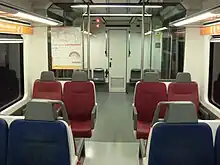
The trains on the Barcelona–Vallès Line are currently the 112, 113 and 114 Series. There are a total of 66 electrical multiple units, all of which are disabled-accessible, air-conditioned and equipped with the automatic train protection (ATP) security system.[37] The trains are technically very similar, though the 112 Series are notably different than the 113 and 114 Series in their design. They all feature the colors of the Ferrocarrils de la Generalitat de Catalunya (FGC) logo—white and orange.[38][39][40]
An initial 16-unit set of 112 Series trains started operating on the line between 1995 and 1996, and another 6-unit set did so in 2003. Considering both their technical features and design, the 112 Series are almost identical to the 213 Series that run on the Llobregat–Anoia Line. The latter, however, feature 1,000 mm (3 ft 3+3⁄8 in) metre gauge and consist of three cars, while the 112 Series feature 1,435 mm (4 ft 8+1⁄2 in) standard gauge and consist of four cars.[41] The entry into service of the first set of 112 Series trains allowed for the implementation of the current Vallès Metro high-frequency line scheme as well as the removal of the former three-car 400 Series in 1996.[38] Together with the Brill 10–27, Brill 301–312 and 600 Series units, the 400 Series were originally operated by Ferrocarriles de Cataluña (FCC) and one unit of each series is preserved as part of FGC's historical rolling stock.[42][43][44][45] The 112 Series is used on services on the Terrassa, Sabadell and Reina Elisenda branches.[38]
Before the entry into service of the 113 and 114 Series throughout 2014, a former 20-unit set of the three-car 111 Series trains had run on the line. These trains started operating between 1983 and 1987, and were the line's first modern electrical multiple units.[46] From January 2014 on, a 19-unit set of the four-car 113 Series trains progressively started operating on the Sabadell, Terrassa and Reina Elisenda branches together with the 112 Series.[47] In December of the same year, a 5-unit set of the three-car 114 Series trains started operating on the Avinguda Tibidabo branch, whose station platforms are too short to hold four-car trains such as the 112 and 113 Series.[48] The 113 and 114 Series are identical in both their technical features and design, though they differ in the number of cars and present some modifications on the seat layout.[40] After the arrival of the 113 and 114 Series, 111 Series trains were removed from circulation and dismantled. Yet, one unit has been preserved as part of FGC's historical rolling stock.[49]
In December 2017, FGC ordered 15 new four-car EMUs, designated the 115 Series, from Stadler Rail's ex-MACOSA facility with entry into service planned for 2019.[50]
| Series | Image | Type | Top speed | Number | Cars per set |
Seats | Total capacity |
Entry into service |
References | |
|---|---|---|---|---|---|---|---|---|---|---|
| km/h | mph | |||||||||
| 112 Series | 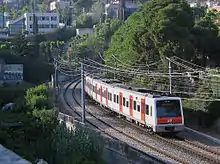 |
Electrical multiple unit | 90 | 56 | 22 | 4 | 232 | 722 | 1995–1996, 2003 | [38] |
| 113 Series |  |
19 | 4 | 188 | 780 | 2014 | [47] | |||
| 114 Series | 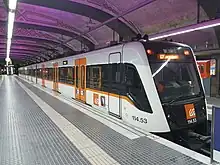 |
5 | 3 | 124 | 605 | [48] | ||||
| 115 Series | 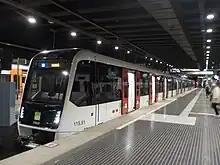 |
— | — | 15 | 4 | — | — | 2019 | [50] | |
List of stations
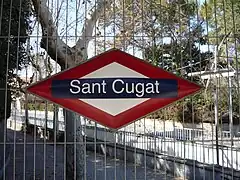
The following table lists the name of each station on the Barcelona–Vallès Line in order from south to north; a photo of the current station; the rail services operating at the station—L6, L7, L12, S1, S2, S5, S6 and S7—; if applicable, the date the current station was opened; the municipality or the city district (in the case of Barcelona) in which each station is or will be located; the fare zone each station belongs or will belong to according to the Autoritat del Transport Metropolità (ATM) fare-integrated public transport system;[51] remarkable notes about the station, including clarifications, additional information and a location map; and usage figures.
| # | Terminal of a service |
| * | Transfer station |
| #* | Transfer station and terminal |
| ‡ | Non-accessible station |
| ‡# | Non-accessible, terminal station |
| ‡* | Non-accessible, transfer station |
| § | Station under construction |
| † | Closed station |
| ¤ | Station located in Barcelona; city district indicated instead of municipality |
| ● | The train stops at the station |
| | | The train skips the station |
| Station | Photo | Line(s) | Opened | Municipality | Fare zone |
Notes | Usage[lower-alpha 1] | |||||||
|---|---|---|---|---|---|---|---|---|---|---|---|---|---|---|
| Main route | ||||||||||||||
| Pl. Catalunya#* | .jpg.webp) |
● | ● | No service | ● | ● | ● | ● | ● | 24 Apr 1929 | Eixample¤ | 1 | Original at-grade station opened on 23 June 1863. Connects with Rodalies de Catalunya commuter and regional rail services, as well as with Barcelona Metro lines 1 and 3.map 1 | 11.35 |
| Provença* | .jpg.webp) |
● | ● | ● | ● | ● | ● | ● | 24 Apr 1929 | Eixample¤ | 1 | Original at-grade station opened 18 August 1882. Connects with Barcelona Metro lines 3 and 5 at Diagonal station.map 2 | 8.2 | |
| Gràcia |  |
● | ● | ● | ● | ● | ● | ● | 24 Apr 1929 | Gràcia–Sarrià-Sant Gervasi¤ | 1 | Original at-grade station opened 23 June 1863.map 3 | 2.76 | |
| Av. Tibidabo branch | ||||||||||||||
| Pl. Molina* | .jpg.webp) |
No service | ● | No service | No service | No service | No service | No service | No service | 1 Jan 1954 | Sarrià-Sant Gervasi¤ | 1 | In 2009, it was linked to Sant Gervasi station, on the line's main route, offering a transfer to L6, S5 and S55 services.[52]map 4 | 0.21 |
| Pàdua | 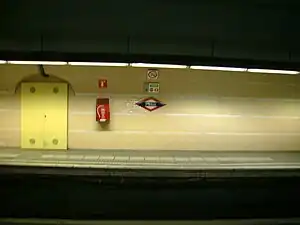 |
● | 1 Jan 1954 | Sarrià-Sant Gervasi¤ | 1 | map 5 | 0.64 | |||||||
| El Putxet‡ |  |
● | 1 Jan 1954 | Sarrià-Sant Gervasi¤ | 1 | map 6 | 1.42 | |||||||
| Av. Tibidabo#* | 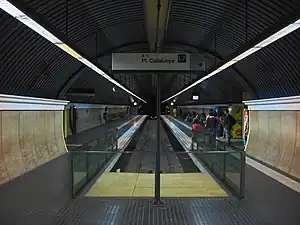 |
● | 1 Jan 1954 | Sarrià-Sant Gervasi¤ | 1 | Connects with the heritage streetcar Tramvia Blau.map 7 | 1.56 | |||||||
| Main route | ||||||||||||||
| Sant Gervasi* | .jpg.webp) |
● | No service | No service | | | | | ● | ● | ● | 24 Apr 1929 | Sarrià-Sant Gervasi¤ | 1 | Original at-grade station opened 23 June 1863. In 2009, it was linked to Plaça Molina station, on the Av. Tibidabo branch, offering a transfer to the L7.[52]map 8 | 1.01 |
| Muntaner | 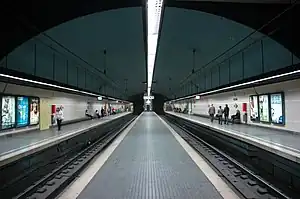 |
● | ● | ● | ● | ● | ● | 20 Jun 1953 | Sarrià-Sant Gervasi¤ | 1 | Original at-grade station opened 30 June 1908.map 9 | 2.76 | ||
| La Bonanova | 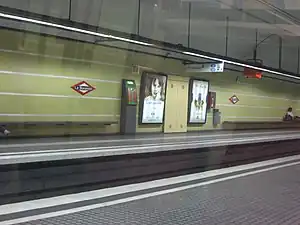 |
● | | | | | ● | ● | ● | 12 May 1952 | Sarrià-Sant Gervasi¤ | 1 | Original at-grade station opened 1887.map 10 | 0.93 | ||
| Les Tres Torres |  |
● | | | | | ● | ● | ● | 12 May 1952 | Sarrià-Sant Gervasi¤ | 1 | Original at-grade station opened 17 December 1906.map 11 | 1.05 | ||
| Sarrià‡# |  |
● | ● | ● | ● | ● | ● | ● | 2 Oct 1976 | Sarrià-Sant Gervasi¤ | 1 | Original at-grade station opened 23 June 1863.map 12 | 3.45 | |
| Reina Elisenda branch | ||||||||||||||
| Reina Elisenda# |  |
No service | No service | ● | No service | No service | No service | No service | No service | 2 Oct 1976 | Sarrià-Sant Gervasi¤ | 1 | map 13 | 0.87 |
| Main route | ||||||||||||||
| Peu del Funicular‡* | 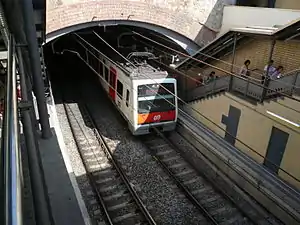 |
● | ● | | | | | | | 28 Nov 1916 | Sarrià-Sant Gervasi¤ | 1 | Connects with the Vallvidrera Funicular.map 14 | 0.35 | |||
| Baixador de Vallvidrera |  |
● | ● | | | | | | | 28 Nov 1916 | Sarrià-Sant Gervasi¤ | 1 | map 15 | 0.38 | |||
| Les Planes | 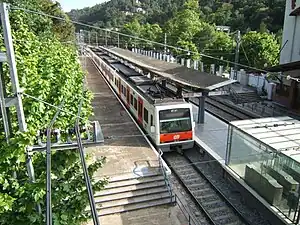 |
● | ● | | | | | | | 28 Nov 1916 | Sarrià-Sant Gervasi¤ | 1 | map 16 | 0.37 | |||
| La Floresta |  |
● | ● | ● | ● | ● | 9 Aug 1925 | Sant Cugat del Vallès | 2C | map 17 | 0.39 | |||
| Valldoreix | 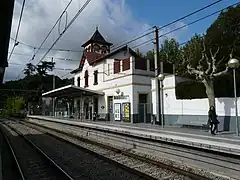 |
● | ● | ● | ● | ● | 3 May 1931 | Sant Cugat del Vallès | 2C | map 18 | 1.06 | |||
| Sant Cugat# | 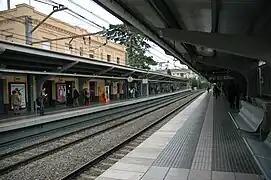 |
● | ● | ● | ● | ● | 26 Oct 1917 | Sant Cugat del Vallès | 2C | map 20 | 3.43 | |||
| Terrassa branch | ||||||||||||||
| Mira-sol | 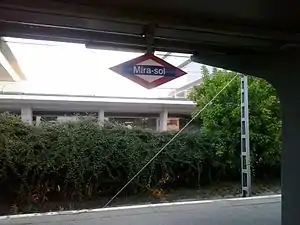 |
No service | No service | No service | ● | No service | No service | No service | ● | 1948 | Sant Cugat del Vallès | 2C | map 20 | 0.52 |
| Hospital General | 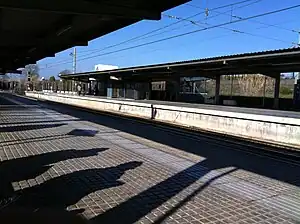 |
● | ● | 1985 | Sant Cugat del Vallès | 2C | map 21 | 0.44 | ||||||
| Rubí# | 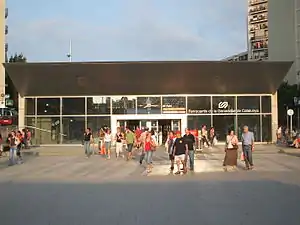 |
● | ● | 13 Sep 1918 | Rubí | 2C | map 22 | 2.08 | ||||||
| Les Fonts | ● | No service | 28 Dec 1919 | Terrassa | 3C | map 23 | 0.38 | |||||||
| Terrassa Rambla |  |
● | 16 May 1986 | Terrassa | 3C | Original at-grade station opened 28 December 1919.map 24 | 2.17 | |||||||
| Vallparadís Universitat |  |
● | 28 Jul 2015 | Terrassa | 3C | map 25 | — | |||||||
| Terrassa Estació del Nord* | ● | 28 Jul 2015 | Terrassa | 3C | Connects with Rodalies de Catalunya commuter and regional rail services.map 26 | — | ||||||||
| Terrassa Nacions Unides# | ● | 28 Jul 2015 | Terrassa | 3C | map 27 | — | ||||||||
| Sabadell branch | ||||||||||||||
| Volpelleres* | .JPG.webp) |
No service | No service | No service | No service | ● | No service | ● | No service | 5 Jun 2010 | Sant Cugat del Vallès | 2C | Connects with Rodalies de Catalunya's Barcelona commuter rail service line R8 at Sant Cugat del Vallès railway station (about 700 m or 2,300 ft).[53]map 28 | 0.58 |
| Sant Joan |  |
● | ● | Sep 1965 | Sant Cugat del Vallès | 2C | map 29 | 0.94 | ||||||
| Bellaterra | 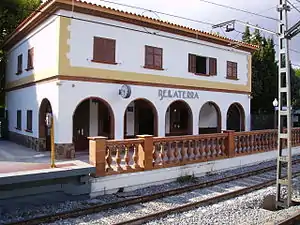 |
● | ● | 22 Jun 1930 | Cerdanyola del Vallès | 2C | map 30 | 0.47 | ||||||
| Autonomous University# |  |
● | ● | 8 Oct 1984 | Cerdanyola del Vallès | 2C | map 31 | 1.65 | ||||||
| Sant Quirze |  |
● | No service | 1 Jun 1922 | Sant Quirze del Vallès | 2C | map 32 | 0.71 | ||||||
| Can Feu | Gràcia | ● | 13 Sep 2016 | Sabadell | 2C | Original at-grade station opened 1 June 1922. Known as Sabadell Estació prior to September 2016. map 33 | 0.71 | ||||||||
| Sabadell Rambla† | .JPG.webp) |
| | 21 Sep 1925 | Sabadell | — | Station closed 13 September 2016 after the first phase of the Sabadell branch extension project opened for passenger service.map 34 | 1.33 | |||||||
| Sabadell Plaça Major | ● | 13 Sep 2016 | Sabadell | 2C | map 35 | — | ||||||||
| La Creu Alta | — | ● | 20 Jul 2017 | Sabadell | 2C | map 36 | — | |||||||
| Sabadell Nord* | — | ● | 20 Jul 2017 | Sabadell | 2C | This station offers connections with Rodalies de Catalunya commuter and regional rail services.map 37 | — | |||||||
| Sabadell Parc del Nord# | — | ● | 20 Jul 2017 | Sabadell | 2C | map 38 | — | |||||||
Future

A three-station extension of L12 from Reina Elisenda to a new transfer station at Finestrelles - Sant Joan de Déu in the Esplugues de Llobregat municipality, where an extension of Barcelona Metro L3 is also under construction, is expected to be opened in 2030.
See also
Maps
- ^map 1 Pl. Catalunya – 41.386025°N 2.168669°E
- ^map 2 Provença – 41.392856°N 2.157928°E
- ^map 3 Gràcia – 41.399086°N 2.152635°E
- ^map 4 Pl. Molina – 41.401692°N 2.146748°E
- ^map 5 Pàdua – 41.403502°N 2.142757°E
- ^map 6 El Putxet – 41.405823°N 2.139152°E
- ^map 7 Av. Tibidabo – 41.409643°N 2.137163°E
- ^map 8 Sant Gervasi – 41.401067°N 2.147130°E
- ^map 9 Muntaner – 41.398531°N 2.142334°E
- ^map 10 La Bonanova – 41.397814°N 2.136428°E
- ^map 11 Les Tres Torres – 41.397801°N 2.130811°E
- ^map 12 Sarrià – 41.398497°N 2.125570°E
- ^map 13 Reina Elisenda – 41.398746°N 2.118929°E
- ^map 14 Peu del Funicular – 41.409215°N 2.111178°E
- ^map 15 Baixador de Vallvidrera – 41.420093°N 2.096931°E
- ^map 16 Les Planes – 41.427401°N 2.091616°E
- ^map 17 La Floresta – 41.444873°N 2.073165°E
- ^map 18 Valldoreix – 41.457842°N 2.068300°E
- ^map 19 Sant Cugat – 41.467912°N 2.078219°E
- ^map 20 Mira-sol – 41.469367°N 2.061380°E
- ^map 21 Hospital General – 41.476250°N 2.046510°E
- ^map 22 Rubí – 41.486297°N 2.031350°E
- ^map 23 Les Fonts – 41.528478°N 2.033598°E
- ^map 24 Terrassa Rambla – 41.559742°N 2.007527°E
- ^map 25 Vallparadís Universitat – 41.563315°N 2.018918°E
- ^map 26 Terrassa Estació del Nord – 41.570400°N 2.015713°E
- ^map 27 Terrassa Nacions Unides – 41.581092°N 2.013278°E
- ^map 28 Volpelleres – 41.481232°N 2.072882°E
- ^map 29 Sant Joan – 41.490185°N 2.076455°E
- ^map 30 Bellaterra – 41.500844°N 2.090587°E
- ^map 31 Autonomous University – 41.502834°N 2.102541°E
- ^map 32 Sant Quirze – 41.529977°N 2.088769°E
- ^map 33 Can Feu | Gràcia – 41.542549°N 2.100441°E
- ^map 34 Sabadell Rambla – 41.545464°N 2.109235°E
- ^map 35 Sabadell Plaça Major – 41.547647°N 2.108716°E
- ^map 36 Sabadell Eix Macià – 41.554987°N 2.100471°E
- ^map 37 Sabadell Nord – 41.560582°N 2.096812°E
- ^map 38 Sabadell Ca n'Oriac – 41.570953°N 2.089860°E
Notes
- All usage figures (entry only) are in millions per year for 2013.[26]
References
- "Memòria de Ferrocarrils de la Generalitat de Catalunya" (PDF). Ferrocarrils de la Generalitat de Catalunya. 2018. p. 76. Retrieved 5 September 2019.
- "Entra en servei el perllongament d'FGC a Terrassa" [FGC's Terrassa extension opens for passenger service] (PDF). Sala de premsa (Press release) (in Catalan). Department of Public Works and Transport. Government of Catalonia.; Ferrocarrils de la Generalitat de Catalunya. 29 July 2015. Archived from the original (PDF) on 5 October 2015. Retrieved 31 July 2015.
- "President Puigdemont: "El perllongament d'FGC a Sabadell és un compromís insubornable amb el transport públic i la mobilitat sostenible"" [President Puigdemont: "FGC's Sabadell extension is an incorruptible commitment to public transport and sustainable mobility"] (PDF). Sala de premsa (Press release) (in Catalan). Department of Public Works and Transport. Government of Catalonia. 20 July 2017. Retrieved 2 January 2018.
- Un año de obras en el centro de Sabadell para hacer 5 paradas de FGC – 20minutos.es
- "El Govern també paralitza el 'metro de Terrassa i Sabadell." Diari Ara (Barcelona), 26 January 2012, p.10
- Perllongament de la línia d'FGC a Sabadell – DPTOP Archived 28 August 2007 at the Wayback Machine
- Vecinos de Sabadell cuestionan la prolongación de los Ferrocarrils | El Periódico de Catalunya | Barcelona
- S'anima el debat sobre les obres del "Metro de Sabadell" :: sabadellcruilla.org :: Sabadell, cruïlla de camins
- Agrupament Ferroviari de Barcelona » Blog Archive » Comencen els treballs per a executar els túnels del perllongament d’FGC a Terrassa
- "Acords de Govern. Generalitat de Catalunya". Archived from the original on 5 July 2008. Retrieved 9 September 2016.
- Nova estació de Renfe a Terrassa Archived 10 October 2007 at the Wayback Machine
- Notícies – Terrassa.net : Una gran ciutat per viure-hi
- Borràs, Bernat. "Gràcia". trenscat.cat (in Catalan). Retrieved 14 September 2014.
- Borràs, Bernat. "Línia Barcelona-Vallès – Característiques tècniques" [Barcelona–Vallès Line – Technical features]. trenscat.cat (in Catalan). Retrieved 14 September 2014.
- Google (14 September 2014). "Overview map of the Barcelona–Vallès Line and its service routes" (Map). Google Maps. Google. Retrieved 14 September 2014.
- "El túnel ferroviari d'Horta" [Horta railway tunnel] (in Catalan). Department of Public Works and Transport. Generalitat of Catalonia. Retrieved 14 September 2014.
- Borràs, Bernat. "Línia Barcelona-Vallès – Perllongament Metro del Vallès a Terrassa" [Barcelona–Vallès Line – Metro del Vallès extension in Terrassa]. trenscat.cat (in Catalan). Retrieved 17 June 2015.
- Distance measured using Google Maps's "Distance Measurement Tool".
- Borràs, Bernat. "Línia Barcelona-Vallès – Perllongament Metro del Vallès a Sabadell" [Barcelona–Vallès Line – Metro del Vallès extension in Sabadell]. trenscat.cat (in Catalan). Retrieved 17 June 2015.
- "Accessibility Improvements at FGC Stations". Ferrocarrils de la Generalitat de Catalunya. Retrieved 20 September 2022.
- "Barcelona–Vallès Line". Ferrocarrils de la Generalitat de Catalunya. Retrieved 17 June 2015.
- "El Centre de Comandament Integrat de Rubí assumeix el control de la línia Llobregat-Anoia" [The Integrated Control Center in Rubí takes over the control of the Llobregat–Anoia Line] (PDF). Sala de premsa (Press release) (in Catalan). Ferrocarrils de la Generalitat de Catalunya. 5 June 2010. Retrieved 14 September 2014.
- Borràs, Bernat. "Terrassa Nacions Unides i dipòsit de trens de Can Roca" [Terrassa Nacions Unides and Can Roca Depot]. trenscat.cat (in Catalan). Retrieved 31 July 2015.
- "Inici dels treballs d'enderrocament dels antics tallers d'FGC a Sarrià" [Start of the dismantling of FGC's former repair shops in Sarrià]. Sala de premsa (Press release) (in Catalan). Generalitat of Catalonia. 26 May 2009. Retrieved 17 June 2015.
- Borràs, Bernat. "Estació Sabadell-Ca n'Oriac i dipòsit de trens" [Sabadell-Ca n'Oriac station and depot]. trenscat.cat (in Catalan). Retrieved 2 January 2018.
- FGC (2013), p. 62
- "School time schedule of lines S1 and S5" (PDF). Ferrocarrils de la Generalitat de Catalunya. July 2015. Retrieved 15 May 2015.
- "School time schedule of lines S2 and S55" (PDF). Ferrocarrils de la Generalitat de Catalunya. July 2015. Archived from the original (PDF) on 26 July 2015. Retrieved 15 May 2015.
- "School time schedule of the lines serving Pl. Catalunya station" (PDF). Ferrocarrils de la Generalitat de Catalunya. March 2015. Retrieved 17 June 2015.
- "FGC aprova una reorganització del servei per ajustar l'oferta a la demanda i racionalitzar despeses a les línies metropolitanes" [FGC passes a service reorganization to adapt the service supply to the demand as well as to mainstream costs at the metropolitan lines] (PDF). Sala de premsa (Press release) (in Catalan). Ferrocarrils de la Generalitat de Catalunya. 20 December 2011. Retrieved 17 June 2015.
- Borràs, Bernat. "Línia Barcelona-Vallès – Línies" [Barcelona–Vallès Line – Lines]. trenscat.cat (in Catalan). Retrieved 17 June 2015.
- Borràs, Bernat. "Línia Barcelona-Vallès – Línia L7 Pl. Catalunya – Av. Tibidabo" [Barcelona–Vallès Line – Line L7 Pl. Catalunya – Av. Tibidabo]. trenscat.cat (in Catalan). Retrieved 17 June 2015.
- "Tres línies de FGC a Barcelona canvien de nomenclatura per adaptar-se a la resta de la xarxa ferroviària" [The designation of three FGC lines in Barcelona is changed to coordinate it with the rest of the railway system] (PDF) (in Catalan). VilaWeb. 30 October 2003. Retrieved 10 May 2015.
- "El Metro del Vallès i les línies urbanes de Sarrià i avinguda Tibidabo" [The Vallès Metro and the Sarrià and Avinguda Tibidabo urban lines]. Actuacions i obres (in Catalan). Department of Public Works and Transport. Generalitat of Catalonia. Archived from the original on 18 June 2015. Retrieved 17 June 2015.
- FGC (2013), p. 58
- Julià Sort, Jordi (October 2013). Sagrera i la xarxa ferroviària de Barcelona [Sagrera and Barcelona's railway system] (in Catalan). Barcelona: Viena Edicions. p. 143. ISBN 978-84-8330-740-3.
- "Tren: 112" [Train: 112]. Transporte Barcelona (in Spanish). Retrieved 17 June 2015.
- Borràs, Bernat. "Línia Barcelona-Vallès – Trens – Unitats sèrie 112" [Barcelona–Vallès Line – Trains – 112 Series units]. trenscat.cat (in Catalan). Retrieved 17 June 2015.
- Borràs, Bernat. "Línia Barcelona-Vallès – Trens – Unitats sèrie 113" [Barcelona–Vallès Line – Trains – 113 Series units]. trenscat.cat (in Catalan). Retrieved 17 June 2015.
- Borràs, Bernat. "Línia Barcelona-Vallès – Trens – Unitats sèrie 114" [Barcelona–Vallès Line – Trains – 114 Series units]. trenscat.cat (in Catalan). Retrieved 17 June 2015.
- Borràs, Bernat. "Trens – Unitats 213" [Trains – 213 units]. trenscat.cat (in Catalan). Retrieved 17 June 2015.
- Borràs, Bernat. "Línia Barcelona-Vallès – Trens històrics – Brill 18" [Barcelona–Vallès Line – Historical trains – Brill 18]. trenscat.cat (in Catalan). Retrieved 17 June 2015.
- Borràs, Bernat. "Línia Barcelona-Vallès – Trens històrics – Brill 301" [Barcelona–Vallès Line – Historical trains – Brill 301]. trenscat.cat (in Catalan). Retrieved 17 June 2015.
- Borràs, Bernat. "Línia Barcelona-Vallès – Trens històrics – Unitat 400 "Granota"" [Barcelona–Vallès Line – Historical trains – 400 Unit "Frog"]. trenscat.cat (in Catalan). Retrieved 17 June 2015.
- Borràs, Bernat. "Línia Barcelona-Vallès – Trens històrics – Unitat 600 "Perico"" [Barcelona–Vallès Line – Historical trains – 600 Unit "Perico"]. trenscat.cat (in Catalan). Retrieved 17 June 2015.
- Borràs, Bernat. "Línia Barcelona-Vallès – Trens – Unitats sèrie 111" [Barcelona–Vallès Line – Trains – 111 Series units]. trenscat.cat (in Catalan). Retrieved 17 June 2015.
- "Els nous trens de la sèrie 113 d'FGC comencen a circular pel Metro del Vallès" [The new 113 Series trains start running on the Vallès Metro] (PDF). Sala de premsa (Press release) (in Catalan). Department of Public Works and Transport. Generalitat of Catalonia.;Ferrocarrils de la Generalitat de Catalunya. 27 January 2014. Archived from the original (PDF) on 18 June 2015. Retrieved 17 June 2015.
- "La línia L7 d'FGC estrena els nous trens de la sèrie 114" [The new 114 Series trains start running on FGC line L7] (PDF). Sala de premsa (Press release) (in Catalan). Ferrocarrils de la Generalitat de Catalunya. 20 December 2014. Archived from the original (PDF) on 5 May 2015. Retrieved 17 June 2015.
- "FGC ven i subhasta per internet material de les unitats de tren de la sèrie 111" [FGC sells and auctions off elements of the 111 Series trains through the Internet] (PDF). Sala de premsa (Press release) (in Catalan). Ferrocarrils de la Generalitat de Catalunya. 20 October 2014. Archived from the original (PDF) on 18 June 2015. Retrieved 17 June 2015.
- "FGC orders 15 EMUs from Stadler Rail Valencia". International Railway Journal. 10 January 2018. Retrieved 16 March 2018.
- Integrated Railway Network (PDF) (Map). Autoritat del Transport Metropolità. June 2015. Retrieved 7 November 2015.
- "El DPTOP completa la connexió i millora de les estacions d'FGC de Sant Gervasi i Pl. Molina" [The Department of Public Works and Transport finishes the linkage and improvement of FGC's Sant Gervasi and Pl. Molina stations] (PDF). Sala de premsa (Press release) (in Catalan). Department of Public Works and Transport. Generalitat of Catalonia. 19 April 2010. Archived from the original (PDF) on 24 June 2015. Retrieved 24 June 2015.
- "El president Montilla posa en servei la nova estació d'FGC de Volpelleres" [President Montilla opens FGC's new Volpelleres station] (PDF). Sala de premsa (Press release) (in Catalan). Department of Public Works and Transport. Generalitat of Catalonia.; Tabasa. 5 June 2010. Archived from the original (PDF) on 18 June 2015. Retrieved 14 September 2014.
Bibliography
- Salmerón i Bosch, Carles (1988). El Tren del Vallès: Història dels ferrocarrils de Barcelona a Sabadell i Terrassa [The Vallès Train: History of the Barcelona to Sabadell and Terrassa railways]. Els Trens de Catalunya-13B (in Catalan). Terminus. ISBN 84-404-3560-6.
- Memòria de Ferrocarrils de la Generalitat de Catalunya 2013 [2013 Report of Ferrocarrils de la Generalitat de Catalunya] (PDF) (Report) (in Catalan). Ferrocarrils de la Generalitat de Catalunya; Department of Public Works and Transport. Generalitat of Catalonia. 2014. Retrieved 14 September 2014.
External links
- Ferrocarrils de la Generalitat de Catalunya (FGC) official website Archived 31 January 2018 at the Wayback Machine
- Barcelona–Vallès Line at trenscat.cat (in Catalan)
- Barcelona–Vallès Line at Rodalia.info. Real-time status updates of the line by its users via Twitter.
- Photo collection of the Barcelona–Vallès Line on Flickr
- Playlist containing videos of stations on the Barcelona–Vallès Line on YouTube